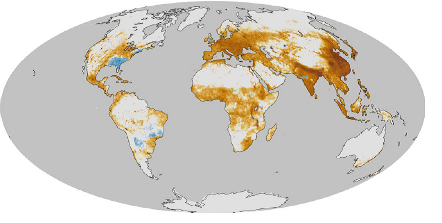The India-California Air Mitigation Pollution Program (ICAMP) was jointly launched by University of California at San Diego, The Energy and Resources Institute (TERI) of India, California Air Resource Board (CARB), and the World Bank on October 21, 2013. The program is co-chaired by Dr. R. K. Pachauri, Director-General of TERI and Chair of the Intergovernmental Panel on Climate Change (IPCC), Ms. Mary Nichols, Chair of CARB, and Prof. V. Ramanathan. Governor of California Jerry Brown, who delivered a key-note speech in the inauguration, stressed the importance of shifting public opinion in the fight to reduce air and climate pollution. California’s emissions reductions have occurred at the same time California’s population and economy have both grown strongly. The inauguration was followed by a 3-day knowledge exchange workshop. The workshop, arranged by the UCSD in partnership with TERI, included representatives from the Indian Federal Government, three Indian states, CARB as well as industry and non-government organizations. Delegates discussed how science, engineering, technology, economics, history, policy and politics all play a role in understanding the problem and methods to solve it.
California’s emissions reductions have occurred at the same time California’s population and economy have both grown strongly.
According to the experts gathered in California, each year about 620,000 people are killed by ambient PM pollution alone in India. This number for the globe is 3.2 million, including some 200,000 in the US, of which more than one-tenth is in California. Transport sector, especially diesel vehicles, is a major contributor of PM emissions. Pollutants from diesel are also believed more toxic than other PMs. According to Dr. Linda Smith, Chief of Health and Exposure Assessment Branch of CARB, diesel PM emissions represent 70-80% of all air cancer risk. In the US, the west coast state suffers more than any other due to its distinctive geography and climate that traps air in valleys. Severe smog in the 1940s caused a major public outcry and the Californian Government now has some of the world’s toughest air pollution policies and cleanest vehicles. Through various policy interventions, California has successfully reduced its BC concentration by 90% from 1960 to 2010 while consumption of diesel increased by a factor of four.
India’s transportation sector is experiencing impressive growth. The number of vehicles has grown from about 20 million in 1991 to about 140 million in 2011. Air pollution has become a major problem in cities with PM concentrations exceeding standards by factors of 5 to 10 in major cities. A recent report by Financial Times indicated that the PM10 level peaked at 1560 mg/m3 at one of the monitoring stations in Delhi which is more than 30 times the WHO standard – 50 mg/m3. In cities like Bangalore, the transportation sector contributes more than 50% to PM2.5 (as of 2011), nearly the same as in California. This explains why Indian government officials and experts are looking to California for lessons.
According to UCSD scholar, Prof. V. Ramanathan, California’s efforts to reduce air pollution, particularly from diesel transportation, cut soot concentrations by 90% since 1966. This has not only improved public health, but also avoided the equivalent of 21 million metric tons of carbon dioxide emissions annually (about the same as taking more than 4 million vehicles off the road every year). In his speech, Dr. Pachauri, emphasized the need to reduce SLCPs, such as ‘black carbon’ from diesel, which impact the climate in a matter of weeks, months and years. This focus is timely given the IPCC’s latest report suggests humans are now only decades away from being locked into a course of dangerous climate change and SLCP reduction may buy us more time before the world enters catastrophic warming. Reducing SLCPs pollutants complement efforts to reduce carbon dioxide, which warm the atmosphere over decades and centuries. According to the Integrated Assessment of Black Carbon and Tropospheric Ozone (2012) by UNEP and WMO, full implementation of the 16 identified measures to mitigating SLCPs would reduce future global warming by 0.5˚C (within a range of 0.2–0.7˚C).
“SLCPs offer the important opportunity to address the risk of climate change while reducing the impacts of air pollution on public health and protecting agricultural production and reducing regional impact such as accelerated glacier melt and its effect on river systems in the region”, said Chandra Shekhar Sinha, Task Team Leader of the project in South Asia Region’s Disaster Risk and Climate Change team.
India’s transport emissions could be reduced by policies and investments promoting a systemic shift of passengers and freight to more efficient, lower-emissions forms of transport as well as by more direct regulatory and policy approaches aimed at encouraging more efficient, lower-emitting vehicles. The gains from a shift in modes of transport are significant. A series of initiatives including stricter vehicle emissions standards, durability requirements and in use vehicle testing could reduce emissions by 85% of where they otherwise might be through 2030 and reduce premature deaths to 230,000 by 2030. However, India’s institutional and policy knots must be untied to achieve these emissions reductions. Policies to promote shifts in mode of transport – e.g. from road to rail for freight or private vehicles to public transport in cities – are intertwined with broader public investment and governance challenges. Regulations on fuel efficiency and emissions are tightening, but still contentious. Enforcement must be strengthened, which in turn requires streamlining responsibility and building capacity to enforce existing rules.
The Program has now established working groups on science, technology and governance, which, over the next six months, will design measures to reduce India’s air pollution and propose an Action Plan to high-level policy makers. The Program will also explore options for pilot projects to reduce diesel emissions in a major Indian cities and states. The working groups will research and consult on a set of options to be narrowed down at the next meeting with high-level policy makers, scheduled for February 2014 in New Delhi, India.

